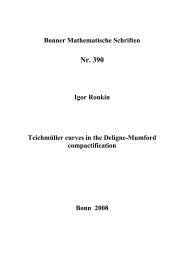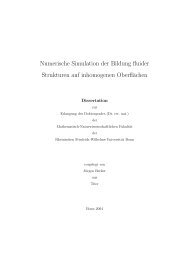Orientation reversal of manifolds - Universität Bonn
Orientation reversal of manifolds - Universität Bonn
Orientation reversal of manifolds - Universität Bonn
You also want an ePaper? Increase the reach of your titles
YUMPU automatically turns print PDFs into web optimized ePapers that Google loves.
30 3 Examples in every dimension ≥ 3<br />
For the chirality <strong>of</strong> the even-dimensional examples, we use the cup product<br />
structure in cohomology in a way which cannot be reduced to the intersection<br />
or linking form as in the simpler examples <strong>of</strong> Chapter 2.<br />
3.1<br />
Examples in every odd dimension ≥ 3<br />
Theorem 23<br />
In every odd dimension ≥ 3, there is a closed orientable manifold that does<br />
not admit a continuous map to itself with degree −1.<br />
Examples <strong>of</strong> such <strong>manifolds</strong> will be provided by mapping tori <strong>of</strong> n-dimensional<br />
tori T n = S 1 × . . . × S 1 . Although the base space S 1 and the fibre T n<br />
are amphicheiral, the fibration is twisted in a way that makes orientation <strong>reversal</strong><br />
impossible. We can exclude orientation-reversing maps by studying<br />
the endomorphisms <strong>of</strong> the fundamental group. Therefore, we first work out<br />
some properties <strong>of</strong> the kind <strong>of</strong> groups which we will encounter as fundamental<br />
groups.<br />
Lemma 24<br />
Abelianisation is a right exact functor.<br />
Although abelianisation as a functor is left adjoint to the inclusion <strong>of</strong> abelian<br />
groups into all groups, the simple category-theoretic argument “left adjoint<br />
functors are right exact” only applies to abelian categories. Therefore, the<br />
exactness property is checked ad hoc.<br />
Pro<strong>of</strong>. Clearly, abelianisation is functorial. Consider the following commutative<br />
diagram, where the middle row is assumed to be exact and the columns<br />
are exact by definition <strong>of</strong> the commutator subgroup and abelianisation. The<br />
surjectivity <strong>of</strong> the map [B, B] → [C, C] follows from the surjectivity <strong>of</strong> B → C.<br />
1 1<br />
[B, B] [C, C] 1<br />
A B C 1<br />
∗<br />
A ab B ab C ab 1<br />
1 1 1





